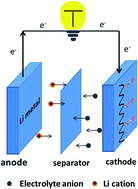Recent progress in carbonyl-based organic polymers as promising electrode materials for lithium-ion batteries (LIBs)
Abstract
Lithium-ion batteries (LIBs) have been demonstrated as one of the most promising energy storage devices for applications in electric vehicles, smart grids, large-scale energy storage systems, and portable electronics. Compared with traditional inorganic compounds that often cause various environmental problems, organic electrode materials possess many advantages, such as the diversity of molecular structures, feasibility of subjective design, light weight, low cost, high theoretical capacity, and eco-friendliness, making them very promising in the application of energy-related devices. Among all organic materials used as electrodes for LIBs, organic carbonyl-based polymers with multi-electron reaction centers, high theoretical capacity, reaction reversibility, rapid redox kinetics, and the inhibition of electrolyte dissolution have recently become hot topics. In this review, we summarize the recent progress in the design, synthesis, and application of carbonyl-based polymers for LIBs. In addition, the advantages/disadvantages of individual materials are also discussed.



 Please wait while we load your content...
Please wait while we load your content...